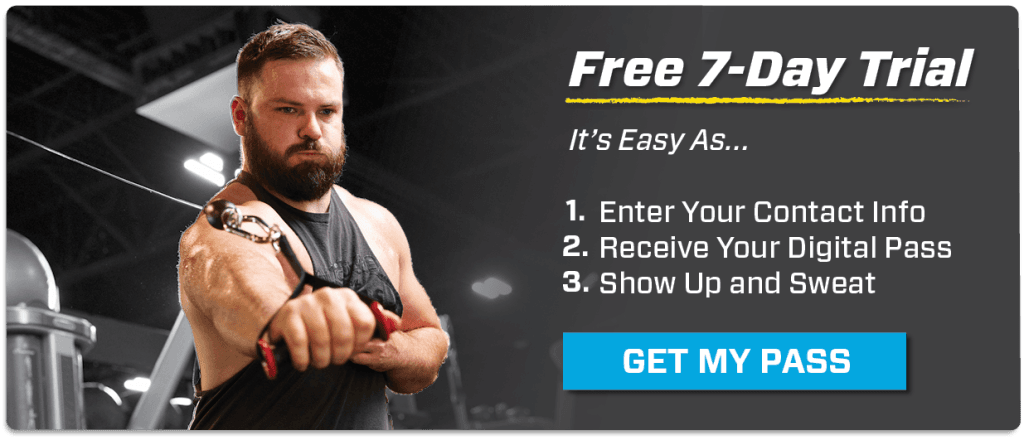10 SHOULDER EXERCISES FOR STRENGTH AND STABILITY
Fitness Tips
Apr 25, 2024 • 10min read
Strengthening your shoulders offers more than an enhanced physique; it builds a solid foundation for overall health and fitness. This guide to 10 essential shoulder exercises targets the critical muscle groups in your shoulders to improve your functional strength and reduce your risk of injury. Whether you’re just starting or looking to intensify your routine, these exercises can help you progress at your own pace.
WHAT YOU WILL LEARN:
WHY SHOULDER STABILITY IS IMPORTANT
Shoulder stability is the key to moving safely and effectively in the gym and daily life. At its core, having stable shoulders is about preventing injuries. Your shoulder is one of the most mobile joints in your body, making it one of the most vulnerable. By strengthening the muscles around your shoulder joint, you create a ‘safety net’ that reduces the risk of dislocations, strains and other common injuries.
Shoulder stability can also help improve your posture. Many of us tend to slouch or round our shoulders forward daily, especially those who sit at a desk all day. This slouching can lead to pain and discomfort. Strengthening and stabilizing your shoulder muscles can counteract these tendencies, aligning your spine to reduce the strain on your back and neck.
Working on your shoulder stability can also help improve your mobility in and out of the gym. The reason is that your shoulder joint is integral to many movements, from lifting and pushing to throwing and swinging. Whether reaching for a high shelf, playing a round of golf or carrying a child, strong and stable shoulders help you perform these actions with ease and confidence.
DUMBBELL SHOULDER EXERCISES
Dumbbell exercises are a staple for building strong, sculpted shoulders. These free weights offer versatility and allow for a natural range of motion, targeting various parts of the shoulder muscles. While the following workouts are designed with dumbbells in mind, you can use other free weights, such as kettlebells, if you prefer. It’s important to remember to warm up your muscles for 5-10 minutes before starting the workout to help prevent injury.
Standing Dumbbell Shoulder Press
This exercise works your entire shoulder area, particularly your anterior (front) deltoids, and engages your triceps and upper back. It’s great for building overall shoulder strength and stability.

How to do it: Stand with your feet shoulder-width apart and hold a dumbbell in each hand at shoulder height. Your spine should be straight and your core engaged. Keeping your elbows pointed towards the front of your body, press the dumbbells upward, extending your arms fully above your head. Keep your wrists straight during this movement and avoid locking your elbows. Keep your knees slightly bent to avoid arching your back. Slowly lower the dumbbells back down to your starting position, moving your elbows directly downward rather than flaring to the side. Repeat this movement for 8-12 reps.
Modification: For those with lower back issues or beginners, perform the exercise seated to help maintain good form and reduce strain.
Dumbbell Lateral Raises
This exercise isolates the lateral (side) deltoid muscles in your shoulders, which is crucial for developing shoulder width that improves body symmetry.
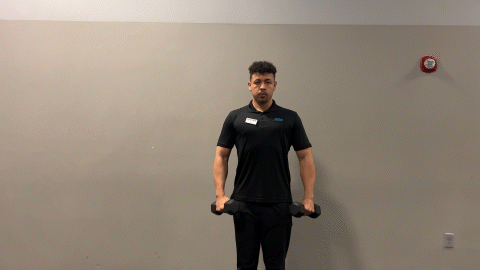
How to do it: Stand with your feet hip-width apart and hold a dumbbell in each hand at your sides. Keep your spine straight, core engaged and knees slightly bent. Lift the weights to your sides, slightly bending your elbows until your arms are straight out in front of you, parallel to the floor. Your palms should face down, and your shoulders should remain down and back, not hunched over your ears. Lower the dumbbells back to the starting position with controlled motion. Repeat this movement for 8-12 reps.
Reverse Fly
The reverse fly targets your posterior (rear) deltoids and upper back muscles, promoting better posture and balanced shoulder development.
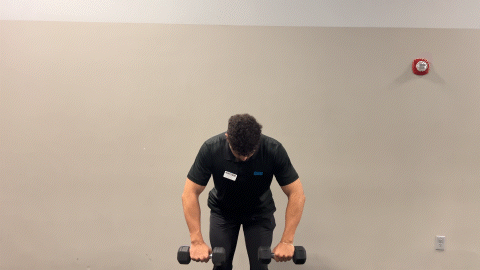
How to do it: Bend at your hips with your knees slightly bent and back flat, arms hanging straight down and holding dumbbells. With a slight bend in your elbows, lift your arms straight out from your sides until they align with your upper body. Squeeze your shoulder blades together at the top of the movement. Lower the weights back down slowly to your starting position. Repeat for 8-12 reps.
Modification: Use lighter dumbbells to decrease the strain on your muscles and joints.
Plank Dumbbell Shoulder Raises
This exercise combines core stabilization with shoulder strengthening, targeting your anterior (front) deltoids and engaging your entire core.
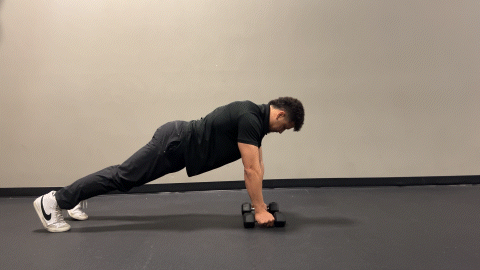
How to do it: Start in a plank position with a dumbbell in each hand directly under your shoulders. Your body should be straight from your head to your feet, with your hips tucked to engage your core. Raise one dumbbell out in front to shoulder height, keeping your arm straight and core engaged. Lower the dumbbell slowly back to the ground and repeat on the other side. Ensure your hips remain level and do not rotate or sag. Repeat for 8-12 reps on each side.
Modification: Perform this exercise from a modified plank position by dropping your knees to the ground, which can reduce the body weight you have to support. To increase control, try using hexagon dumbbells instead of round dumbbells. Unlike round dumbbells, which can roll and shift unpredictably, hexagon dumbbells have flat surfaces that ensure they stay in place when set down. This additional stability helps you maintain proper form throughout the exercise.
CABLE SHOULDER EXERCISES
Cable exercises are highly beneficial for shoulder training because they provide constant tension on the muscles, leading to better muscle engagement and growth. Unlike free weights, which can have points of the exercise where the muscle is not under load, cable machines keep the muscles working hard throughout the entire range of motion.
Cable Front Raise
This exercise focuses on your anterior deltoids, enhancing front shoulder strength and improving your upper body’s overall shape.
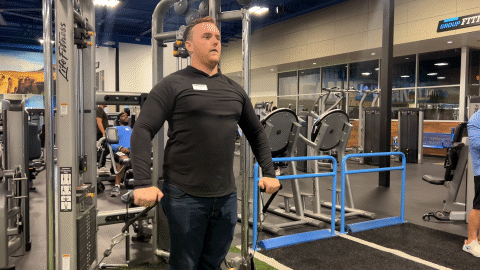
How to do it: Stand facing away from a cable machine, feet hip-width apart, with a handle in each hand. Start with your arms by your sides, then raise them straight out in front of you to shoulder height, keeping a slight bend in your elbows. Ensure your back remains straight and your core engaged. Lower the handles back down slowly to the starting position. Repeat for 8-12 reps.
Modification: For those needing to adjust intensity, you can perform one arm at a time or use a lighter weight.
Cable Lateral Raise
Cable lateral raises target the middle part of your deltoid muscle, helping to define your shoulders and improve lateral arm strength.
How to do it: Stand by the side of the cable machine and grab the handle with your hand furthest from the machine. Keep your other hand on your hip or the machine for balance. With a slight bend in your elbow, lift your arm across your body until it’s straight out in front of you at shoulder height, then lower it back down with control. Perform 8-12 reps, then switch sides.
Modification: Reduce weight or perform this exercise on your knees if standing causes discomfort or instability.
Cable Face Pulls
This exercise can help enhance your rear deltoids and upper back, which are the muscles crucial for improving posture and shoulder stability.
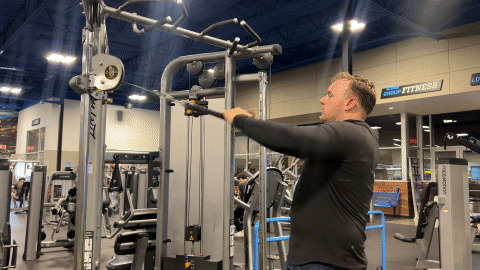
How to do it: Face the cable machine with the rope attachment at upper chest height. Grasp the rope with both hands, with your thumbs pointed upwards and your palms facing each other, ensuring your elbows are bent and positioned higher than your wrists. Pull the rope towards your face, spreading your hands apart as you pull, then slowly return to the starting position while keeping tension in the cable. Perform 8-12 reps.
Modification: Adjust the weight or stand closer to the machine to reduce the pull strength if needed.
BARBELL SHOULDER WORKOUTS
Barbell workouts are another cornerstone of shoulder training. Exercises like the barbell overhead press powerfully engage the entire shoulder region, promoting strength and muscle development. The rigidity of the barbell helps maintain a stable and consistent path during exercise, which is beneficial for developing symmetrical strength.
Upright Row
This exercise targets your deltoids and traps, building strength and improving neck and shoulder contour.

How to do it: Stand with your feet shoulder-width apart and hold a barbell in front of you with an overhand grip. Pull the barbell upwards along your body until it reaches chest level, with your elbows pointing outwards and higher than your hands. Lower the barbell back to the starting position with control. Perform 8-12 reps.
Modification: Use a lighter weight or dumbbell if the barbell is too intense or you’re experiencing discomfort in your wrists or shoulders.
Barbell Overhead Press
The barbell overhead press works your entire shoulder region and triceps, promoting upper body strength and shoulder stability.
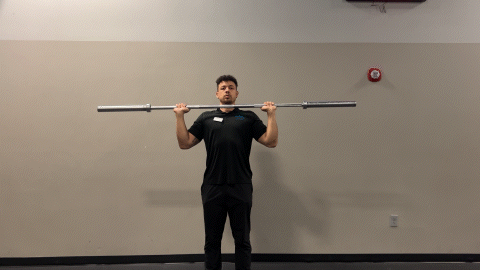
How to do it: Stand with your feet shoulder-width apart and hold a barbell at shoulder height with an overhand grip. Press the barbell upward until your arms are fully extended above your head. Keep your core engaged and avoid arching your back. Lower the barbell back to shoulder height. Repeat for 8-12 reps.
Modification: To modify the standing barbell press, try reducing your weight or performing the exercise seated on a bench with back support, ensuring good posture. This seated position helps stabilize the back and reduces strain on the lower back area. You can also use dumbbells instead of a barbell, which allows for a more natural range of motion and individual arm movement, accommodating any imbalances and reducing stress on the shoulders and lower back.
Barbell Landmine Face Pull
This exercise strengthens your rear deltoids and upper back, aiding in posture correction and overall shoulder health.
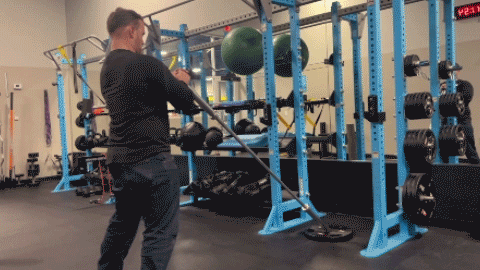
How to do it: Secure one end of a barbell in a landmine attachment or corner. Hold the free end of the bar with both hands, standing with feet hip-width apart. Pull the bar towards your face, keeping your elbows high, then slowly extend your arms back to the starting position. Perform 8-12 reps.
Modification: Reduce the weight or use a resistance band attached to a stable object to perform a similar pulling motion if this setup is too challenging or unavailable.

HOW MANY REPS SHOULD I DO?
When building strength and stability in your shoulders, the number of repetitions (reps) you do is crucial. A general guideline is to aim for 8-12 reps per set for strength training. If you’re new to an exercise, start with fewer reps and focus on mastering the form. Listening to your body and adjusting the reps based on your feelings is essential. If you can do more than 12 reps easily, you might need to increase the weight to challenge your muscles further.
HOW MUCH WEIGHT SHOULD I LIFT?
Choosing the right weight is critical for an effective shoulder workout. Always opt for a weight that is heavy enough to challenge your muscles but not so heavy that it compromises your form. The last few reps should be challenging but still doable with proper technique. If you’re just starting, it’s better to begin light and gradually increase weight as you get stronger. Remember, maintaining good form is critical to preventing injury and getting the most out of your exercises.
HOW OFTEN SHOULD I TRAIN SHOULDERS EACH WEEK?
The ideal frequency for shoulder training can vary depending on your overall fitness routine and goals. Suppose you’re following a split routine that targets different muscle groups on other days. In that case, training shoulders once a week might be sufficient, especially if you’re intensely working on each muscle group. This cadence allows you to focus on your shoulders with various exercises, ensuring you thoroughly hit all aspects of the muscle group. Try this shoulder workout for your next visit to the gym.
For beginners or those integrating full-body workouts, aiming to include shoulder exercises 1 to 2 times per week can provide a good balance, helping you build strength without overdoing it. This frequency ensures that your shoulders are trained alongside other major muscle groups, contributing to overall body strength and function.
More advanced fitness enthusiasts or those focusing on enhancing shoulder strength and stability might aim for 2 to 3 shoulder workouts per week. This cadence offers a more detailed split routine, where you ensure adequate recovery by not training the same muscle group on consecutive days.
Regardless of your fitness level, listening to your body and adjusting based on how your shoulders feel is critical. Balancing your training with proper rest and recovery is essential for long-term progress and preventing injury.
CRUSH YOUR NEXT SHOULDER WORKOUT WITH EōS!
Solid and stable shoulders are essential for everyday activities and achieving fitness goals. You can build comprehensive strength and stability by incorporating shoulder exercises into your routine. At EōS Fitness, we’re here to support your fitness journey every step of the way. Our Personal Training and Assisted Stretch Program (available at select EōS locations) can help you get the most out of your workouts and ensure you perform each exercise correctly for maximum benefit.
Ready to elevate your fitness routine? Sign up for EōS Fitness’ Free 7-Day Gym Pass and experience guided training to transform your approach to shoulder workouts. Let’s build those strong, capable shoulders together!

